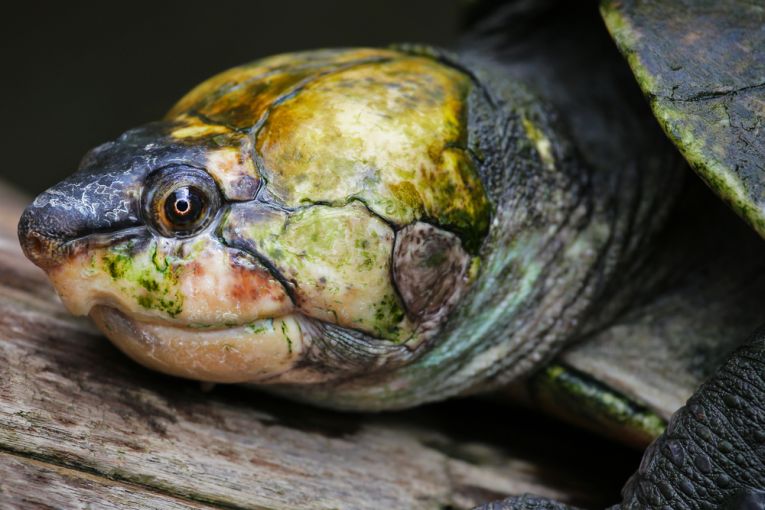There are 207 species or tortoise, terrapin and turtle alive, a lot less than during the lengthy age of reptiles, when poor little mammals quivered in the dark to escape their big cousins. More than half of these, of course, are endangered, given their wetland, marine and other habitats that have led them into confrontation with urban or agricultural, plastic waste or fish-net sprawls. We can all help, even if it’s just to keep plastic out of the oceans or even the streets.
We had one story this year on the pig-nosed turtle, Carettochelys insculptata which was terribly endangered in its Papuan habitat by Indonesian pet traders. Across the Indian Ocean, Madagascan fauna are threatened on all sides by expanding population, poaching, total loss of forest in many areas and in many ways, our ignorance of what lives there.
Astrochelys radiata, the radiated tortoise, is typical of the lemurs, birds and chameleons we have rattled on about for years there. In the south of the island, it’s critically endangered, feeding on the introduced Opuntia cactus as the dry thorn woodland has disappeared. A sister-species, Astrochelys yniphora, the ploughshare tortoise is another Madagascan that’s equally attractive to pet-keepers and now numbers only 200 (last estimate).
All continents have their sad turtle story. The critically-endangered painted terrapin, Batagur borneoensis is not only found in Borneo, but unfortunately can be hardly found at all in SE Asia. Not endangered by pet-keeping, but by Gulf of Mexico shrimp fishermen’s nets is the Kemp’s Ridley sea turtle, one of the rarest animals alive. As females stick to the same beaches every year, many people are trying to preserve their hatchlings nest areas in so far vain attempts to bolster the tiny population.
All the sea turtles are in deadly danger, from the green to the enormous leatherback. These ocean going animals swallow the Pacific gyres’ immense plastic waste patch in mistake for their jellyfish food and are still caught for food in parts of Asia. It is really incredible how long it takes for people in quiet pleasant restaurants to realise that they are eating the last of an animal that they honestly appreciate. Appreciate it more, you idiots, otherwise you certainly won’t see it again.
In the middle of the US, in a little watershed in Alabama, the flattened musk turtle, Sternotherus depressus, has survived for millions of years. Pollution, especially from the dreaded coal-mining now threatens the last few remaining mud-larks. No wonder he’s depressed! In China, Anhui Province has equally reduced examples of relict species. Despite ancient human residents who obviously appreciated this very aquatic box tortoise much more, the remaining 50 to 150 specimens of Cuora aurocapitata, the yellow-headed box tortoise, are still being eaten and traded as pets. Just as in Alabama, the species was restricted to 3 river systems but is likely to be extinct in the wild.Even its nesting beaches have been destroyed by hydro-electric schemes.
Other Chinese box turtles are also critically-endangered, often by the inevitable but horrendous Chinese medicine trade. One highly unsatisfactory situation is the Chinese medicine usage off rare Burmese star tortoises, Geochelone platynota, leading to its almost total loss nowadays. Taipei Zoo is attempting captive breeding and release, but to return these precious young to the wild is certain suicide for every individual.
We’ll have to finish with the sea turtles, and with the 4th largest reptile alive. Dermatochelys coriacea is the famed leatherback, able to patrol even the Arctic with its amazing endothermic metabolism. As a jellyfish predator, “Dermat” is most affected by our human waste consignment of transparent plastic at sea. Another critically-endangered big turtle affected is the hawksbill, Eretmochelys imbricata, which has an Atlantic and a Pacific subspecies. They feed more on sponges, but are also commonly caught by fishermen, whether by accident (by-catch) or design.
To help with any research you need, many terrestrial and freshwater species that are threatened are listed by several organisations, clubbing together with a publication in The Turtle Survival Alliance.










